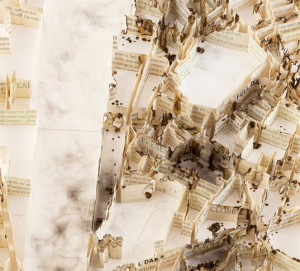![]()
Cities are often described as living organisms; viewed as subject rather than object. Matthew Picton engages with this tradition of humanising the city by deconstructing the clean, uncompromising aesthetic of the cartographic city plan and imbuing it with the unique history and culture of each place.
In London 1940 four panels depict the different wards of east London during World War II. Based on extensive research, Picton’s sculptures are created in accordance with the original bomb damage maps of wartime London. A meticulous record was kept of the damage that occurred to every street and building, and the maps were colour coded to reflect the level of destruction. The finished structures are carefully burned to re-create this record, with the areas of total destruction detailed in the maps completely burnt away in the sculpture. This four part sculpture is intended to create a powerful visual reminder of the ruined state wrought upon the physical body of London by the war.
The architecture of each panel is created from a text that corresponds to the individual wards. Rosie Alison’s The Very Thought of You explores the effects on familial and romantic relations as a result of wartime evacuation. The remaining three panels, based on text from novels by Christopher Fowler, Graham Greene and Elizabeth Bowen, whose works centre around tales of crime and espionage, highlight the criminal underworld that flourished during the war. Together these texts present a portrait of social life in London during the 1940’s.
Venice, another work by Picton, is constructed from excerpts of Death in Venice written by Thomas Mann after his visit to the city in 1911. During his travels he experienced a cholera outbreak and was witness to a strange mixture of official denials, undermined by persistent rumours, creating a sense of unease that features prominently in the text. The novel’s protagonist, Gustav von Aschenbach, falls victim to his own obsessive desires and yearnings in a metaphor for the state of the disease-stricken city of Venice.
The walls of text are also interwoven with segments of the musical score by Benjamin Britten for the operatic interpretation of Mann’s novel — these notes are only visible along the walls facing the Grand Canal and around the circumference of Venice where it meets the water. The work is made from absorbent paper partially soaked in water and mud dredged from the lagoon surrounding Venice. These water stains seeping upwards from the base of the sculpture through the crisp, white paper parallel the unique predicament of Venice as it gradually returns to the water and reference the contamination that spread the water-born cholera through the city.
Picton depicts these cities as active participants, affected by outside sources and shaped by their internal social structure. The city becomes a subject and an entity of its own.
Matthew Picton is a graduate of the London School of Economics. Solo exhibitions include Paper Cities, Christopher Henry Gallery, New York (2012), New Sculptures and Digital Prints, Pulliam Gallery, Portland (2011), In the Case of All Cities, Sumarria Lunn, London (2010), City Planning, Solway Jones Gallery, Los Angeles (2009), Postwar Landscape, An Urban History, Howard House, Seattle (2009), Byron C Cohen Gallery, Kansas City (2007), Toomey Tourell, San Francisco (2007), Damien B Contemporary Art, Miami (2004) and the Center for Contemporary Art, Anchorage (2000). Group shows include Urban Jungle, Lumas Gallery, Stuttgart (2010), The Map as Art, Christopher Henry Gallery, New York (2009), Bakers Dozen, The Torrance Art Museum, Torrance, CA (2009), Contested Ground, Museum of Art, Spokane (2008), Miniature Worlds, The Brewery Art Center, Los Angeles (2004), Indoor Outdoor, Limn Gallery, San Francisco (2003) and 5 Abstract Painters, Lindenberg Gallery, New York (1998).
— — — — — — — — — — — — — —
Private view: Wednesday 7th March / 6 — 9pm
Exhibition runs: Thursday 8th March to Friday 6th April / 11am — 6pm (Tuesday to Friday) / 12 — 5pm (Saturday)
The exhibition will be featured in forthcoming issues of Prospect Magazine (published 23rd February) and Blueprint (published w/c 5th March).
